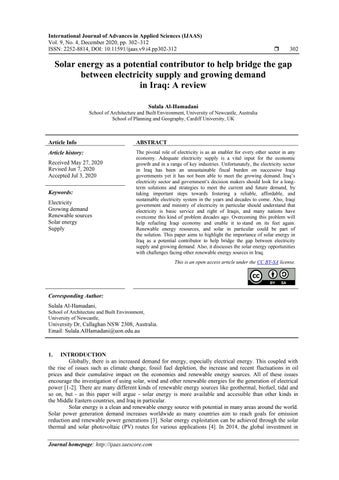International Journal of Advances in Applied Sciences (IJAAS) Vol. 9, No. 4, December 2020, pp. 302~312 ISSN: 2252-8814, DOI: 10.11591/ijaas.v9.i4.pp302-312
302
Solar energy as a potential contributor to help bridge the gap between electricity supply and growing demand in Iraq: A review Sulala Al-Hamadani School of Architecture and Built Environment, University of Newcastle, Australia School of Planning and Geography, Cardiff University, UK
Article Info
ABSTRACT
Article history:
The pivotal role of electricity is as an enabler for every other sector in any economy. Adequate electricity supply is a vital input for the economic growth and in a range of key industries. Unfortunately, the electricity sector in Iraq has been an unsustainable fiscal burden on successive Iraqi governments yet it has not been able to meet the growing demand. Iraq’s electricity sector and government’s decision makers should look for a longterm solutions and strategies to meet the current and future demand, by taking important steps towards fostering a reliable, affordable, and sustainable electricity system in the years and decades to come. Also, Iraqi government and ministry of electricity in particular should understand that electricity is basic service and right of Iraqis, and many nations have overcome this kind of problem decades ago. Overcoming this problem will help refueling Iraqi economy and enable it to stand on its feet again. Renewable energy resources, and solar in particular could be part of the solution. This paper aims to highlight the importance of solar energy in Iraq as a potential contributor to help bridge the gap between electricity supply and growing demand. Also, it discusses the solar energy opportunities with challenges facing other renewable energy sources in Iraq.
Received May 27, 2020 Revised Jun 7, 2020 Accepted Jul 3, 2020 Keywords: Electricity Growing demand Renewable sources Solar energy Supply
This is an open access article under the CC BY-SA license.
Corresponding Author: Sulala Al-Hamadani, School of Architecture and Built Environment, University of Newcastle,
University Dr, Callaghan NSW 2308, Australia. Email: Sulala.AlHamadani@uon.edu.au
1.
INTRODUCTION Globally, there is an increased demand for energy, especially electrical energy. This coupled with the rise of issues such as climate change, fossil fuel depletion, the increase and recent fluctuations in oil prices and their cumulative impact on the economies and renewable energy sources. All of these issues encourage the investigation of using solar, wind and other renewable energies for the generation of electrical power [1-2]. There are many different kinds of renewable energy sources like geothermal, biofuel, tidal and so on, but - as this paper will argue - solar energy is more available and accessible than other kinds in the Middle Eastern countries, and Iraq in particular. Solar energy is a clean and renewable energy source with potential in many areas around the world. Solar power generation demand increases worldwide as many countries aim to reach goals for emission reduction and renewable power generations [3]. Solar energy exploitation can be achieved through the solar thermal and solar photovoltaic (PV) routes for various applications [4]. In 2014, the global investment in Journal homepage: http://ijaas.iaescore.com








